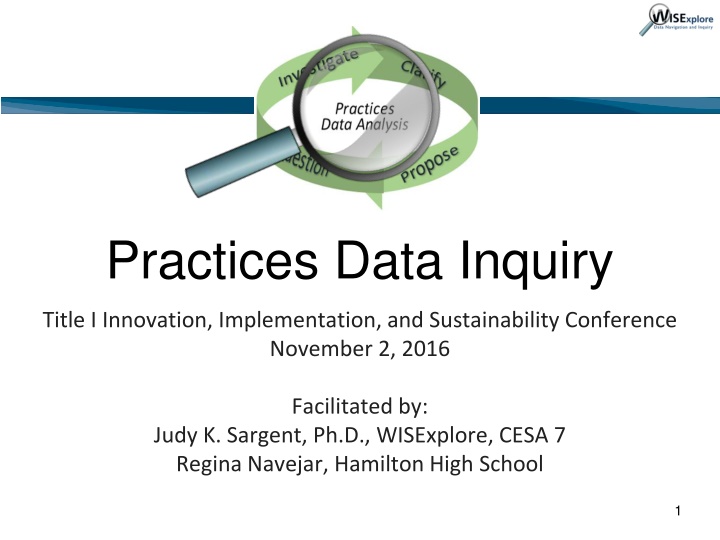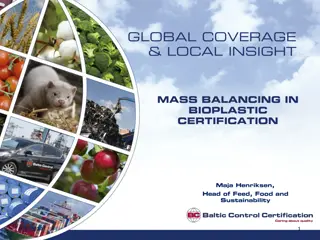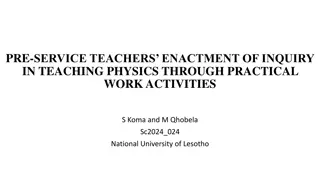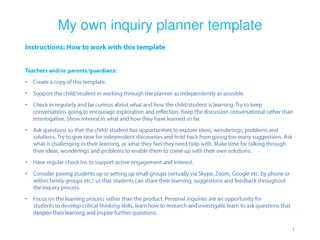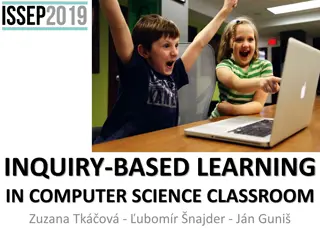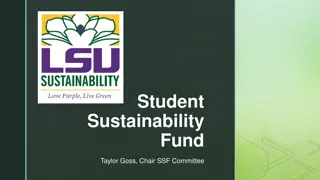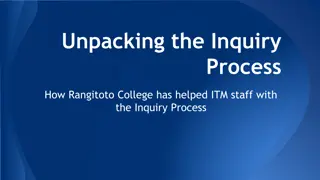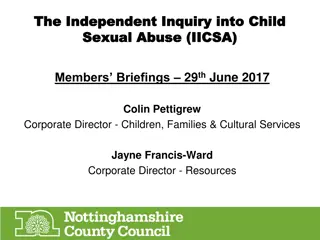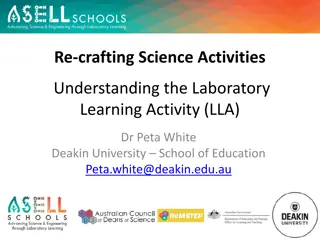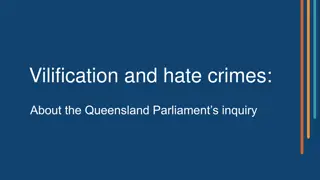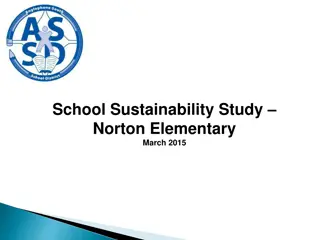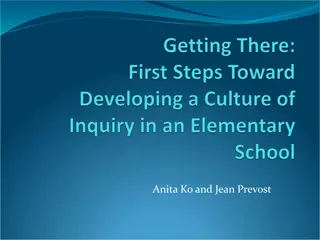Innovation & Sustainability Conference: Data Inquiry for School Improvement
Explore how student data findings drive inquiry into practices, learn to identify and collect data as practice indicators, understand the Practices Data Inquiry process, and reflect on a Wisconsin school's journey from data analysis to practice analysis.
Download Presentation

Please find below an Image/Link to download the presentation.
The content on the website is provided AS IS for your information and personal use only. It may not be sold, licensed, or shared on other websites without obtaining consent from the author.If you encounter any issues during the download, it is possible that the publisher has removed the file from their server.
You are allowed to download the files provided on this website for personal or commercial use, subject to the condition that they are used lawfully. All files are the property of their respective owners.
The content on the website is provided AS IS for your information and personal use only. It may not be sold, licensed, or shared on other websites without obtaining consent from the author.
E N D
Presentation Transcript
Practices Data Inquiry Title I Innovation, Implementation, and Sustainability Conference November 2, 2016 Facilitated by: Judy K. Sargent, Ph.D., WISExplore, CESA 7 Regina Navejar, Hamilton High School 1
Welcome Agenda Introductions Resources Outcomes for this Session To understand how student data findings lead to inquiry into practices. To learn how to identify and collect data as indicators of practices. To learn the Practices Data Inquiry process. To learn about and understand an example from a Wisconsin school who moved from student data analysis to an analysis of practices. To reflect and plan a comprehensive process of inquiry that builds from student data analysis to practices data inquiry. 2
Data Inquiry for School Improvement Mission, Vision, Values and Beliefs 3
Inquiry Throughout the Year Results Inquiry Practices Inquiry Implementation Inquiry 4
Stages of Inquiry Results Inquiry Illuminates Problems and Successes Practices Inquiry Examines Possibilities to Prevent the Problem and Build Upon Successes Implementation Inquiry Monitors and Evaluates Quality and Impact 5
Practices Data Inquiry 6
From Student Results Data to Practices Inquiry Inquiry about their learning ... Inquiry about our work ... 7 What could we do better? How are they learning?
Question. Pose a question about practices likely to be possible root causes for student data findings. 8
Question. Pose a question based on hypotheses of practices. Begin with hypotheses of practices generated from the student data inquiry. Hypothesis of Practice Question for Practices Inquiry Perhaps we are not differentiating for struggling learners in language arts. To what degree are we differentiating our instruction, work assignments and resources in language arts classes? Our data may have improved because we moved more ELL and SpeEd students into core literacy classrooms with co-teaching. What was the nature of the co-teaching training that was provided; and what are the roles the teachers have been playing in the classroom? Maybe our schedules don t provide ample time for students to engage in critical thinking. How much focus exists in teachers lesson plans on critical thinking skills, and for what proportion of the lessons? We have not had any professional development in connecting college readiness standards to our courses. What has been the focus of teachers professional development in the last three years -- and to what degree has it been focused on CCR standards? 9
Consider Categories of Practices Categories of practice help us focus. Beliefs? Schedule? Strategic Assessment? Instruction? Curriculum? Relationships? Interventions? Collaboration? 10
About Hamilton High School Goals 1. Alignment with core/state standards in curriculum, instruction and assessments 2. Accountability including data analysis, attendance, and academic progress as measured by the ACT, STAR scores and Embedded Assessments. 3. A safe and positive school environment. Mission The mission for Alexander Hamilton High School is to provide rigorous academic experiences in a safe and positive environment. Vision To cultivate a collaborative environment that promotes high standards and a quality education. 11
Hamilton Demographics Hamilton is the largest school in Milwaukee Public Schools 1,821 students 71.8% Economically Disadvantaged 25.2% Students in the Special Education Program 11.6% English Language Learners 12
Hamilton HS Data Story Before and After Gains 13
Hamilton HS Data Story Hypotheses. We thought that maybe these student results were because our teachers ... Did not understand reading skills. Did not know or understand effective reading strategies Did not understand how to use effective reading strategies within their content subject. Did not understand how to teach a rigorous skills through variety of reading strategies. 14
Hamilton HS Data Story Questions we had that needed investigation. What reading and writing skills are needed for our students to show achievement on the ACT? What local assessments do we have to inform us about students reading and writing skills? What established effective strategies can we use to teach these reading and writing skills? What reading and writing strategies are teachers using in the classroom? What is the focus of conversations during common planning time? 15
Reflection about Questions Practices Questions: What questions does your team have about practices that may have contributed to student data results? Collaborate to insert questions into the planning template. Team Team 16
Investigate. Design a strategy or source to collect data. Capture data findings. 17
Identify Practice Data Sources Sources must align to the question about practices Types of Practices Sources: Self-Assessment or Perception Surveys with Rating Scales Classroom walk-through observations or instructional rounds with observation checklists or scoring rubrics Inventories of resources, artifacts (lesson plans, IEPs, language plans, etc.), with checklists or scoring rubrics Schedules and time studies Interviews with descriptive data and checklists 18
Information is Data When one collects observations, they are taking data. Data One uses the data from observations to create inferences. Inferences can be called preliminary conclusions since inferences can change with more data. Evidence When one is asked to support an inference, the data you use to support the inference is called Evidence. Data are the information and measurements from an investigation Evidence is a particular subset of data an investigator uses to support or refute a claim 19
Practices: Spheres of Influence and Control 1. On which practices do we focus our energies? 2. Which practices can have the greatest impact on improving student achievement? 20
Practice Data Sources That Connect How do you select practices data sources that will provide good connections to your student data findings? Getting to likely root causes -- which types of practices data will inform improvement in student achievement the most? Student Perception Surveys? Coaching Impact Data? Beliefs Surveys? Professional Development Data? Teacher Self-Assessment of Practices? Materials Inventories? Parent Opinion Surveys? School Climate Surveys? Teacher-Student Relationship Data? Alignment Study Classroom Management Practices Data Instructional Schedules? Classroom Video Tapes? Teacher Interviews of Practices Classroom Walk- Throughs? EE Data? 21
Hamilton HS Data Story Practices we Investigated 1.Skill alignment 2.Skills being taught 3.Students perceptions of strategies 4.Local assessment and data strategies 5.Professional development involvement 6.CLP focus areas 22
1. Investigating Skill Alignment Investigate alignment of course content with test content. ACT Technical Manual STAR Technical Manual What skills are being measured on these tests? 23
ACT/STAR Alignment of Reading Skills 24
2. Investigating Skills Being Taught We chose classroom walk-throughs to investigate skills. Here s how we shaped our classroom walk-throughs. Level 1 - Is it happening? -- yes or no [Is there a reading or writing event during the class period?] We only looked at First Period this time. We used the Qualtrics Tool -- Beta version; basic walk-through observations 25
What did we want to look for in the classrooms? What reading strategies did we want to look for in the classroom? What reading skills did we want to observe were being taught? 26
2. Refining our Walk-Through Observations How our walk-through observations evolved. Added specific reading skills that students should be practicing. Qualtrics became our Data Collection tool https://co1.qualtrics.com/jfe/preview/SV_5j7SwaMjVvb ao3b 27
2. Results of Detailed Walk-Throughs Walk-Through Results (Qualtrics Report) 28
3. Investigate Student Perceptions We chose to ask students what skills they are being taught. We asked students What Active Reading Strategy and skills are you currently practicing in your classroom. We use a word cloud to represent student responses. From 109 certified walk- through observations 29
4. ACT Writing Rubric Investigation Investigate how writing was being assessed in the classroom. 31
5. Professional Development Evidence: Investigate the PD Needs Calibration: Staff members see distinguished models of skills being taught https://co1.qualtrics.com/jfe5/preview/SV_dhBHicULpswqS0t Common Planning: Staff Members report on their PD Needs 32
6. Common Planning Time Investigation Investigate how common planning time was being used. The shift--Staff members report out which Reading skills and Writing skills they are teaching in class. https://co1.qualtrics.com/jfe5/preview/SV_1YRrrLfbJpWdmKh 33
Reflection about Investigations What practices do you think you would investigate? How would you go about investigating those practices? Team Team 34
Clarify. Summarize and communicate practices data findings to staff. 35
Share Results Find a way to display practices data findings Present the data to staff without conclusions Let staff study the data patterns and clarify the results among themselves 36
Sample Data Findings from Practices Investigation Include: Data source, Timeframe, Metrics Samples: A. In 2016-17, 9th grade English, Social Studies and Science teachers used methods to differentiate student work in 75% of walk-through observations, whereas Math teachers provided differentiated student work options in 53% of the walk-throughs, based on the Differentiation Walk-Through forms. B. The Tiered Fidelity Inventory (TFI) Feature 1.9 showed that a formal system around Feedback and Acknowledgement is not in place as measured by the TFI Walkthrough Tool. (Partially implemented) TFI staff survey results showed that at least 90% of staff surveyed responded that they knew the school rules, taught behavior expectations, and have given out positive acknowledgements in the last two months. It was also reported from the TFI that less than 50% of a sample of students responded that they have received behavior feedback in the past two months. C. From an inventory of grades 6-8 literary reading resources, 80% of reading resources reviewed using the Text Complexity for Literary Text form, showed representation and diversity for only age, gender and place. Conversely, there was reference to race, disability, and language in only 16% of the resources reviewed. D. SIR results showed that in the middle school, the use of balanced assessment at the universal level was at full implementation , whereas use of balanced assessment at selected levels was at the infrastructure level. E. Results from a survey of all grades 6-8 math teachers in the two middle schools revealed that 10 of 12 teachers are not following the math program as prescribed. 37
Hamilton HS - Sharing and Clarifying Practices Data Findings We gave the staff the following information and asked them to draw their own conclusions. Data Collection Tool: What Reading skills are being observed and not observed? Common Planning Report: What skills are teachers reporting they are teaching in their class? 38
Teachers Review Class STAR Data After considering the skills that are under taught, teachers look at their student STAR Reading data. Are they focusing on the skills that need to be taught? 39
Results and Framework How we collected walk-through data. How we collected walk-through data. 40
Reflection about Communicating Data Findings How will you communicate and engage staff in findings from an investigation into practices? Team Team 41
Propose. Propose action steps for improvement. 42
Proposing Actions and Next Steps Practices data findings. The team has discovered something about certain practices in the school that may have contributed to student data findings. Sometimes it s important to investigate further. The goal -- to determine those practices that are effective and practices that are ineffective Finding Problems in Practices. Analyzing root causes for performance gaps and determining what s not working well and why Finding Successes in Practices. Analyzing and determining what we re doing well and why it s working Both are Important 43
Hamilton HS Data Story - Proposing Next Steps Hamilton Reading and Writing Plan All Hamilton High School teachers will teach effective Reading and Writing strategies and focus on specific skills that will increase student Reading and Writing achievement. 44
Hamilton HS Data Story - Turning Practices Findings Into Actions Monitoring Plan Hamilton Data Collection Tool: o Departments conduct peer observation walks every 1stWednesday of the month o The Learning Team conducts peer observation walks every 4th Wednesday of the month o The Learning Team reflects on the data and creates a plan (review, revise, revisit) in response to the data Weekly Common Planning Time Report o Departments reflect on the Reading and Writing activities that are being practiced in the classrooms STAR Data Analysis o Departments review grade level and classroom results o Departments compare and consider the STAR reports in light of the Data Collection Tool and Weekly Common Planning Time reports o Teachers will focus on specific skills (as identified by STAR) that students need to practice 45
Reflection Proposing Actions How will you use results from an investigation into practices inform your improvement actions? How would you tweak your improvement plan? Team Team 46
